Monopolies and Government Regulation: Reasons and Methods
VerifiedAdded on 2020/02/24
|13
|2717
|192
Essay
AI Summary
This essay delves into the rationale and methods employed by governments to regulate natural monopolies. It begins by defining monopolies and natural monopolies, highlighting their significance in the economy. The essay then explores the reasons for government intervention, including the high market power of monopolies, their ability to control price levels leading to consumer exploitation, and the inefficiencies that arise due to lack of competition. The analysis further examines various methods of regulation, such as fair rate of return policies, price ceilings, government regulatory bodies, average cost pricing, and marginal cost pricing rules. Examples, like the Australian Energy Regulatory Commission, are provided to illustrate the practical application of these regulatory mechanisms. The essay concludes by emphasizing the importance of government regulation in protecting consumers, ensuring fair pricing, and promoting efficiency in markets dominated by natural monopolies.
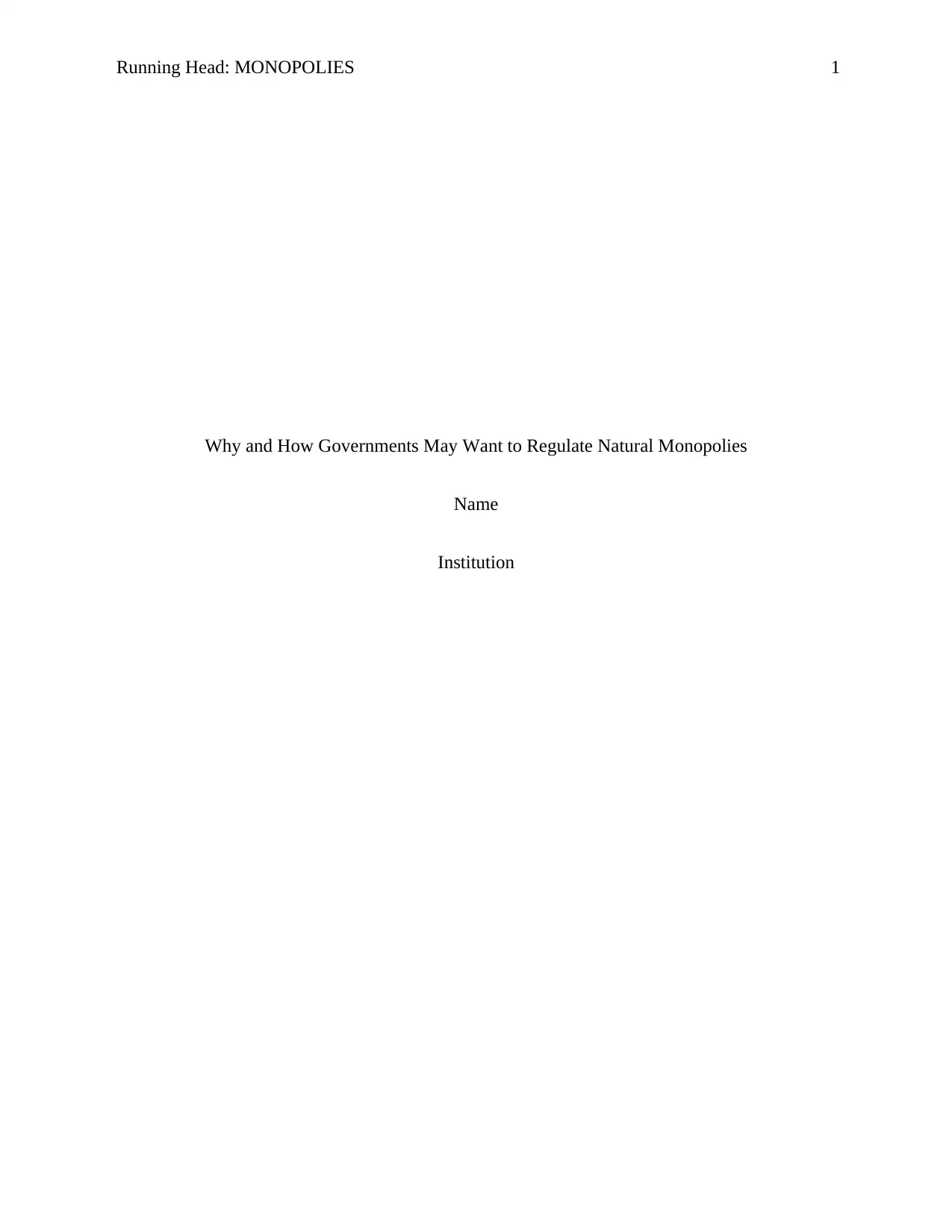
Running Head: MONOPOLIES 1
Why and How Governments May Want to Regulate Natural Monopolies
Name
Institution
Why and How Governments May Want to Regulate Natural Monopolies
Name
Institution
Paraphrase This Document
Need a fresh take? Get an instant paraphrase of this document with our AI Paraphraser
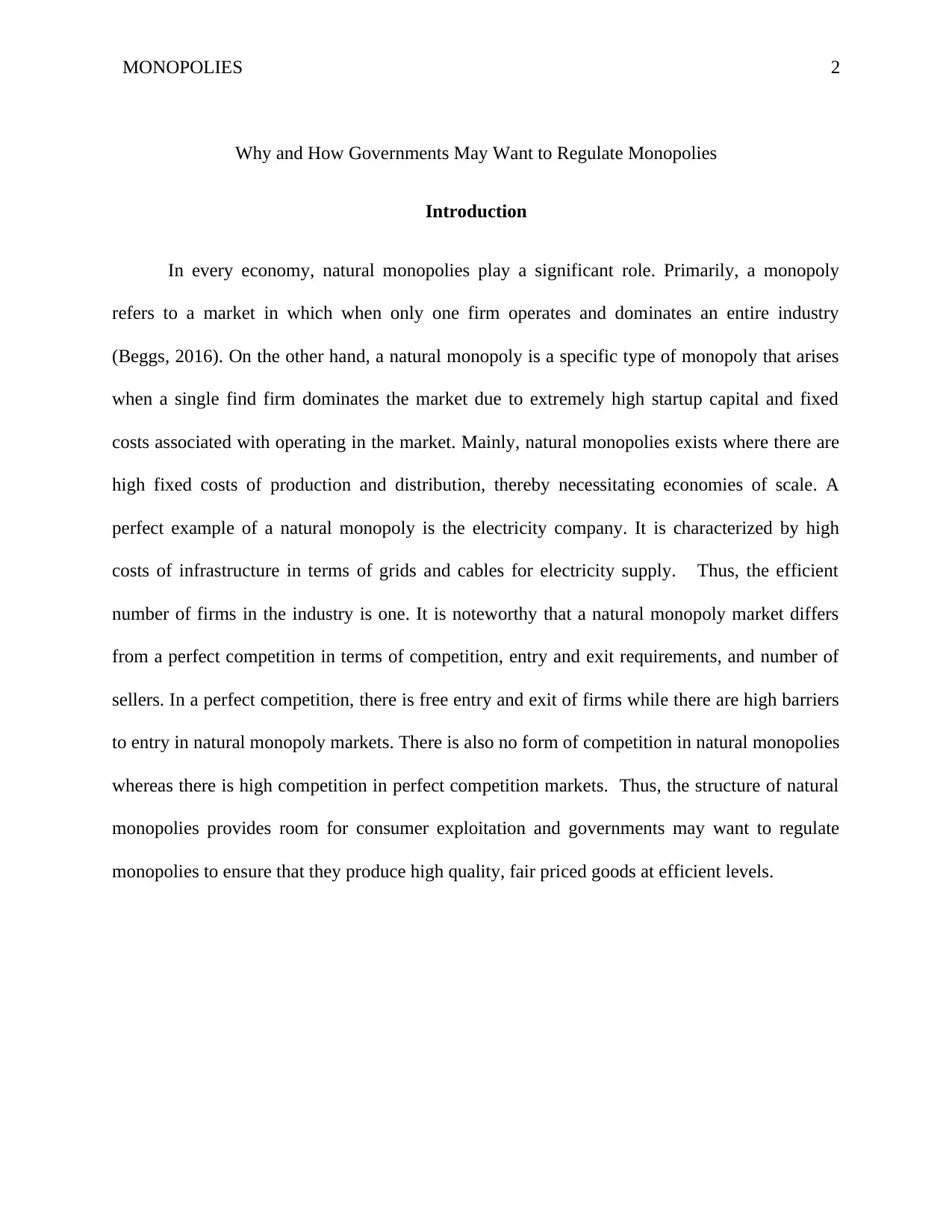
MONOPOLIES 2
Why and How Governments May Want to Regulate Monopolies
Introduction
In every economy, natural monopolies play a significant role. Primarily, a monopoly
refers to a market in which when only one firm operates and dominates an entire industry
(Beggs, 2016). On the other hand, a natural monopoly is a specific type of monopoly that arises
when a single find firm dominates the market due to extremely high startup capital and fixed
costs associated with operating in the market. Mainly, natural monopolies exists where there are
high fixed costs of production and distribution, thereby necessitating economies of scale. A
perfect example of a natural monopoly is the electricity company. It is characterized by high
costs of infrastructure in terms of grids and cables for electricity supply. Thus, the efficient
number of firms in the industry is one. It is noteworthy that a natural monopoly market differs
from a perfect competition in terms of competition, entry and exit requirements, and number of
sellers. In a perfect competition, there is free entry and exit of firms while there are high barriers
to entry in natural monopoly markets. There is also no form of competition in natural monopolies
whereas there is high competition in perfect competition markets. Thus, the structure of natural
monopolies provides room for consumer exploitation and governments may want to regulate
monopolies to ensure that they produce high quality, fair priced goods at efficient levels.
Why and How Governments May Want to Regulate Monopolies
Introduction
In every economy, natural monopolies play a significant role. Primarily, a monopoly
refers to a market in which when only one firm operates and dominates an entire industry
(Beggs, 2016). On the other hand, a natural monopoly is a specific type of monopoly that arises
when a single find firm dominates the market due to extremely high startup capital and fixed
costs associated with operating in the market. Mainly, natural monopolies exists where there are
high fixed costs of production and distribution, thereby necessitating economies of scale. A
perfect example of a natural monopoly is the electricity company. It is characterized by high
costs of infrastructure in terms of grids and cables for electricity supply. Thus, the efficient
number of firms in the industry is one. It is noteworthy that a natural monopoly market differs
from a perfect competition in terms of competition, entry and exit requirements, and number of
sellers. In a perfect competition, there is free entry and exit of firms while there are high barriers
to entry in natural monopoly markets. There is also no form of competition in natural monopolies
whereas there is high competition in perfect competition markets. Thus, the structure of natural
monopolies provides room for consumer exploitation and governments may want to regulate
monopolies to ensure that they produce high quality, fair priced goods at efficient levels.
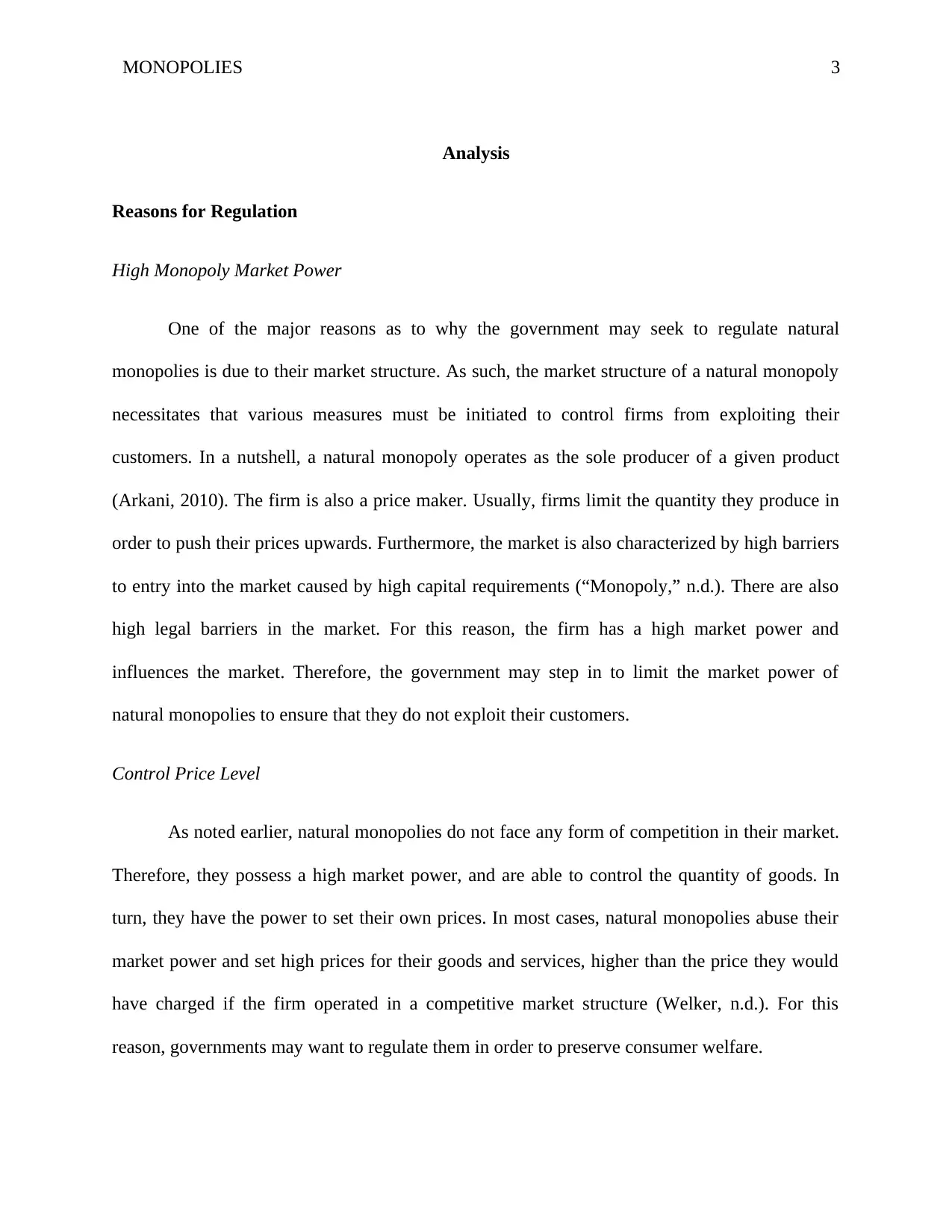
MONOPOLIES 3
Analysis
Reasons for Regulation
High Monopoly Market Power
One of the major reasons as to why the government may seek to regulate natural
monopolies is due to their market structure. As such, the market structure of a natural monopoly
necessitates that various measures must be initiated to control firms from exploiting their
customers. In a nutshell, a natural monopoly operates as the sole producer of a given product
(Arkani, 2010). The firm is also a price maker. Usually, firms limit the quantity they produce in
order to push their prices upwards. Furthermore, the market is also characterized by high barriers
to entry into the market caused by high capital requirements (“Monopoly,” n.d.). There are also
high legal barriers in the market. For this reason, the firm has a high market power and
influences the market. Therefore, the government may step in to limit the market power of
natural monopolies to ensure that they do not exploit their customers.
Control Price Level
As noted earlier, natural monopolies do not face any form of competition in their market.
Therefore, they possess a high market power, and are able to control the quantity of goods. In
turn, they have the power to set their own prices. In most cases, natural monopolies abuse their
market power and set high prices for their goods and services, higher than the price they would
have charged if the firm operated in a competitive market structure (Welker, n.d.). For this
reason, governments may want to regulate them in order to preserve consumer welfare.
Analysis
Reasons for Regulation
High Monopoly Market Power
One of the major reasons as to why the government may seek to regulate natural
monopolies is due to their market structure. As such, the market structure of a natural monopoly
necessitates that various measures must be initiated to control firms from exploiting their
customers. In a nutshell, a natural monopoly operates as the sole producer of a given product
(Arkani, 2010). The firm is also a price maker. Usually, firms limit the quantity they produce in
order to push their prices upwards. Furthermore, the market is also characterized by high barriers
to entry into the market caused by high capital requirements (“Monopoly,” n.d.). There are also
high legal barriers in the market. For this reason, the firm has a high market power and
influences the market. Therefore, the government may step in to limit the market power of
natural monopolies to ensure that they do not exploit their customers.
Control Price Level
As noted earlier, natural monopolies do not face any form of competition in their market.
Therefore, they possess a high market power, and are able to control the quantity of goods. In
turn, they have the power to set their own prices. In most cases, natural monopolies abuse their
market power and set high prices for their goods and services, higher than the price they would
have charged if the firm operated in a competitive market structure (Welker, n.d.). For this
reason, governments may want to regulate them in order to preserve consumer welfare.
⊘ This is a preview!⊘
Do you want full access?
Subscribe today to unlock all pages.

Trusted by 1+ million students worldwide
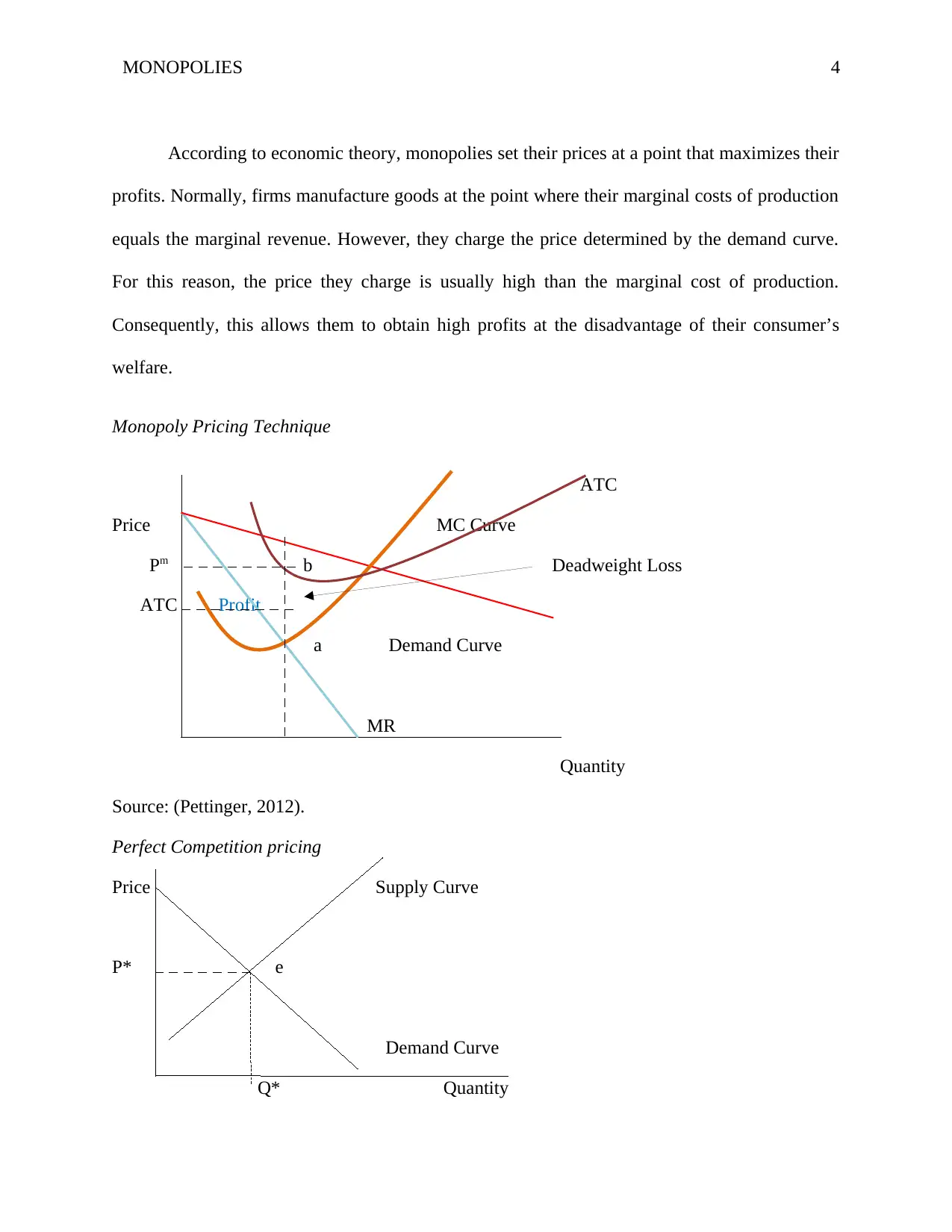
MONOPOLIES 4
According to economic theory, monopolies set their prices at a point that maximizes their
profits. Normally, firms manufacture goods at the point where their marginal costs of production
equals the marginal revenue. However, they charge the price determined by the demand curve.
For this reason, the price they charge is usually high than the marginal cost of production.
Consequently, this allows them to obtain high profits at the disadvantage of their consumer’s
welfare.
Monopoly Pricing Technique
ATC
Price MC Curve
Pm b Deadweight Loss
ATC Profit
a Demand Curve
MR
Quantity
Source: (Pettinger, 2012).
Perfect Competition pricing
Price Supply Curve
P* e
Demand Curve
Q* Quantity
According to economic theory, monopolies set their prices at a point that maximizes their
profits. Normally, firms manufacture goods at the point where their marginal costs of production
equals the marginal revenue. However, they charge the price determined by the demand curve.
For this reason, the price they charge is usually high than the marginal cost of production.
Consequently, this allows them to obtain high profits at the disadvantage of their consumer’s
welfare.
Monopoly Pricing Technique
ATC
Price MC Curve
Pm b Deadweight Loss
ATC Profit
a Demand Curve
MR
Quantity
Source: (Pettinger, 2012).
Perfect Competition pricing
Price Supply Curve
P* e
Demand Curve
Q* Quantity
Paraphrase This Document
Need a fresh take? Get an instant paraphrase of this document with our AI Paraphraser

MONOPOLIES 5
From the graphs above, the MC curve intersects with MR curve at point a (Pettinger,
2012). However, instead of setting its price at this point, the firm locates the demand curve for
the product, thereby setting its price from point b (Pettinger, 2012). At this pricing, the price is
higher than the Average total costs incurred in the production of the good. Thus, the monopoly
makes a profit equal to Pm-ATC (Pettinger, 2012). In contrast, a firm operating in a competitive
market sets its prices at the point where the demand and supply curve intersect. Thus, unlike
natural monopoly, the price is optimal and there is no deadweight loss associated with its pricing.
Therefore, in this regard, the natural monopoly makes supernormal profits and reduces the
welfare of consumers. Thus, the government may find it necessary to step in and regulate the
pricing level.
Enhance Firm’s Efficiency
In addition, governments regulate natural monopolies in order to enhance their level of
efficiency. It is worth noting that monopoly firms are associated with various forms of
inefficiencies. As noted earlier, natural monopolies do not experience any form of competition.
The weakened market forces guarantees that consumers lack other alternatives from which to
purchase the product or service (Beggs, 2017). Thus, the firm does not worry about the
possibilities of losing customers due to their poor quality goods or services. For this reason, they
lack the incentive to improve their level of innovativeness to improve the quality of their
commodities. Subsequently, it translates to wastefulness production of goods and services.
Therefore, in this case, the government seeks to protect consumers against poor quality services
and products by setting and regulating quality standards.
From the graphs above, the MC curve intersects with MR curve at point a (Pettinger,
2012). However, instead of setting its price at this point, the firm locates the demand curve for
the product, thereby setting its price from point b (Pettinger, 2012). At this pricing, the price is
higher than the Average total costs incurred in the production of the good. Thus, the monopoly
makes a profit equal to Pm-ATC (Pettinger, 2012). In contrast, a firm operating in a competitive
market sets its prices at the point where the demand and supply curve intersect. Thus, unlike
natural monopoly, the price is optimal and there is no deadweight loss associated with its pricing.
Therefore, in this regard, the natural monopoly makes supernormal profits and reduces the
welfare of consumers. Thus, the government may find it necessary to step in and regulate the
pricing level.
Enhance Firm’s Efficiency
In addition, governments regulate natural monopolies in order to enhance their level of
efficiency. It is worth noting that monopoly firms are associated with various forms of
inefficiencies. As noted earlier, natural monopolies do not experience any form of competition.
The weakened market forces guarantees that consumers lack other alternatives from which to
purchase the product or service (Beggs, 2017). Thus, the firm does not worry about the
possibilities of losing customers due to their poor quality goods or services. For this reason, they
lack the incentive to improve their level of innovativeness to improve the quality of their
commodities. Subsequently, it translates to wastefulness production of goods and services.
Therefore, in this case, the government seeks to protect consumers against poor quality services
and products by setting and regulating quality standards.

MONOPOLIES 6
Furthermore, natural monopolies also lead to inefficiencies as they reduce the level of
producer and consumer surplus (Beggs, 2017). When compared to the competition market
structure, the total surplus associated with the monopolistic firms is smaller. Mainly, this can
attributed to the fact that monopolies tend to limit the quantity of goods and services they
produce in order to influence prices to move upwards. Thus, a reduction in quantity and an
increase in price of the product shrink the consumer as well as the producer surplus. In this
regard, the government opts to regulate monopolies in order to raise the total surplus to the
society.
Surplus in competition market
Consumer surplus
P* Producer surplus
Q*
Surplus in natural monopoly
P Consumer Surplus
Pm Producer Surplus Deadweight loss
PC MC
MR
Qm QC Quantity
Furthermore, natural monopolies also lead to inefficiencies as they reduce the level of
producer and consumer surplus (Beggs, 2017). When compared to the competition market
structure, the total surplus associated with the monopolistic firms is smaller. Mainly, this can
attributed to the fact that monopolies tend to limit the quantity of goods and services they
produce in order to influence prices to move upwards. Thus, a reduction in quantity and an
increase in price of the product shrink the consumer as well as the producer surplus. In this
regard, the government opts to regulate monopolies in order to raise the total surplus to the
society.
Surplus in competition market
Consumer surplus
P* Producer surplus
Q*
Surplus in natural monopoly
P Consumer Surplus
Pm Producer Surplus Deadweight loss
PC MC
MR
Qm QC Quantity
⊘ This is a preview!⊘
Do you want full access?
Subscribe today to unlock all pages.

Trusted by 1+ million students worldwide

MONOPOLIES 7
Methods for Regulation
Given the reasons above, it is important for the government to regulate the conduct of
natural monopolies within its economy. Mainly, regulation can take the form of price ceilings,
average cost pricing, rate of return regulation and the formulation of regulatory bodies to oversee
and control the conduct of monopolies within the country (Beggs, 2015).
Fair Rate of Return Policies
First, government may employ rate of return policies to control natural monopolies in the
country. Primarily, this technique involves the government setting a particular percentage net
profit that a company must not exceed. Usually, it takes into consideration the size of the firm
and determines a reasonable level of profit from its initial capital. Therefore, in order to ensure
compliance, a firm must ensure that its percent net profit is lower that the set threshold. Thus, the
firm’s rate of return on the invested capital is kept below the maximum rate set by the policy.
Consequently, this ensures that firms set their prices at a point that ensures its rate of return on
initial investment is low. In turn, the prices are set at low levels to ensure compliance. It is
noteworthy that this measure ensures that consumers of that given product are protected from
increases in the price of that particular product.
Price Caps and Ceilings
Notably, this is one of the major forms of regulation that the government can put in place
to regulate monopolies. In a nutshell, price ceilings pertain to the setting of a maximum price that
a firm can charge for its goods and services (Beggs, 2015). It is strategy that states that a
particular product cannot be sold for above a specified price (Beggs, 2015). Thus, firms cannot
Methods for Regulation
Given the reasons above, it is important for the government to regulate the conduct of
natural monopolies within its economy. Mainly, regulation can take the form of price ceilings,
average cost pricing, rate of return regulation and the formulation of regulatory bodies to oversee
and control the conduct of monopolies within the country (Beggs, 2015).
Fair Rate of Return Policies
First, government may employ rate of return policies to control natural monopolies in the
country. Primarily, this technique involves the government setting a particular percentage net
profit that a company must not exceed. Usually, it takes into consideration the size of the firm
and determines a reasonable level of profit from its initial capital. Therefore, in order to ensure
compliance, a firm must ensure that its percent net profit is lower that the set threshold. Thus, the
firm’s rate of return on the invested capital is kept below the maximum rate set by the policy.
Consequently, this ensures that firms set their prices at a point that ensures its rate of return on
initial investment is low. In turn, the prices are set at low levels to ensure compliance. It is
noteworthy that this measure ensures that consumers of that given product are protected from
increases in the price of that particular product.
Price Caps and Ceilings
Notably, this is one of the major forms of regulation that the government can put in place
to regulate monopolies. In a nutshell, price ceilings pertain to the setting of a maximum price that
a firm can charge for its goods and services (Beggs, 2015). It is strategy that states that a
particular product cannot be sold for above a specified price (Beggs, 2015). Thus, firms cannot
Paraphrase This Document
Need a fresh take? Get an instant paraphrase of this document with our AI Paraphraser
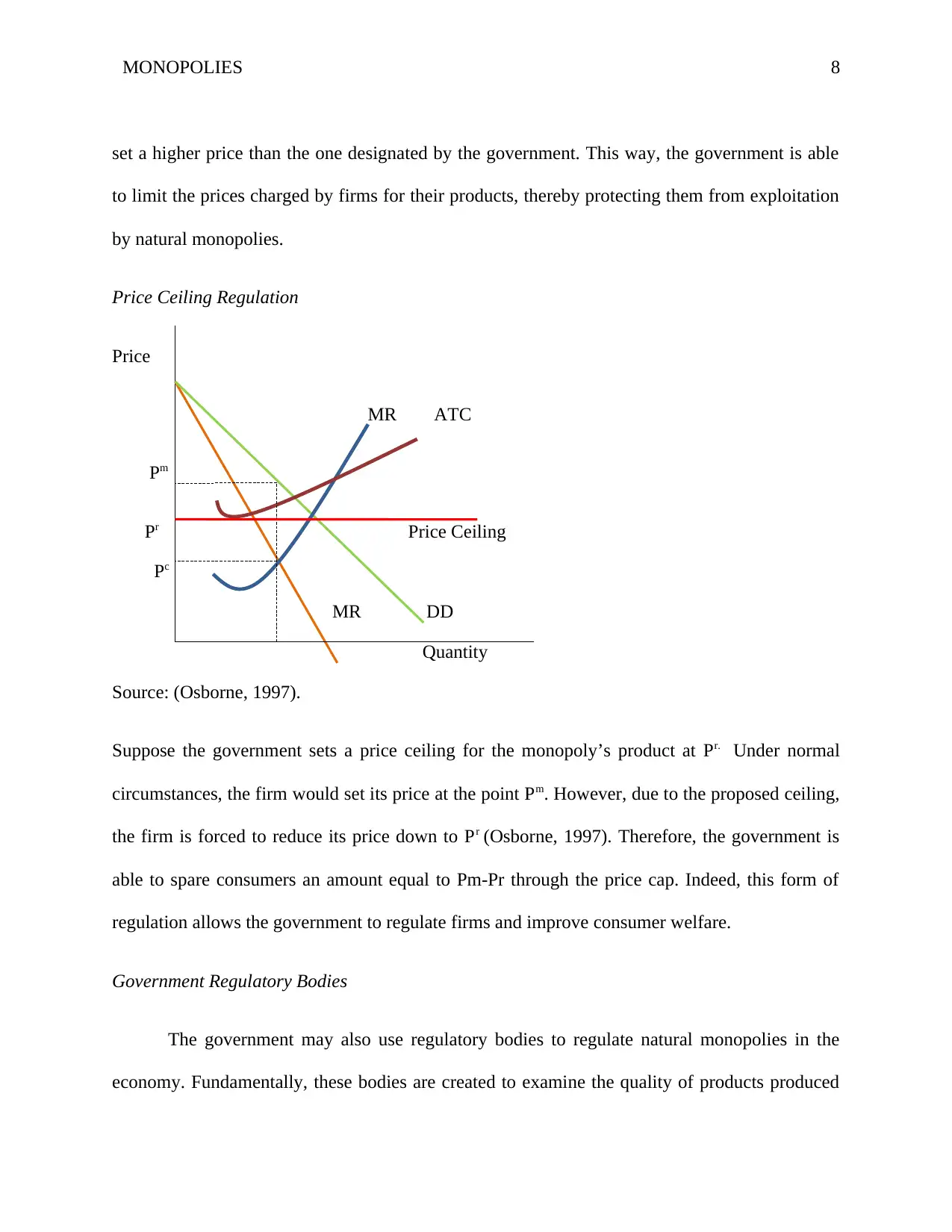
MONOPOLIES 8
set a higher price than the one designated by the government. This way, the government is able
to limit the prices charged by firms for their products, thereby protecting them from exploitation
by natural monopolies.
Price Ceiling Regulation
Price
MR ATC
Pm
Pr Price Ceiling
Pc
MR DD
Quantity
Source: (Osborne, 1997).
Suppose the government sets a price ceiling for the monopoly’s product at Pr. Under normal
circumstances, the firm would set its price at the point Pm. However, due to the proposed ceiling,
the firm is forced to reduce its price down to Pr (Osborne, 1997). Therefore, the government is
able to spare consumers an amount equal to Pm-Pr through the price cap. Indeed, this form of
regulation allows the government to regulate firms and improve consumer welfare.
Government Regulatory Bodies
The government may also use regulatory bodies to regulate natural monopolies in the
economy. Fundamentally, these bodies are created to examine the quality of products produced
set a higher price than the one designated by the government. This way, the government is able
to limit the prices charged by firms for their products, thereby protecting them from exploitation
by natural monopolies.
Price Ceiling Regulation
Price
MR ATC
Pm
Pr Price Ceiling
Pc
MR DD
Quantity
Source: (Osborne, 1997).
Suppose the government sets a price ceiling for the monopoly’s product at Pr. Under normal
circumstances, the firm would set its price at the point Pm. However, due to the proposed ceiling,
the firm is forced to reduce its price down to Pr (Osborne, 1997). Therefore, the government is
able to spare consumers an amount equal to Pm-Pr through the price cap. Indeed, this form of
regulation allows the government to regulate firms and improve consumer welfare.
Government Regulatory Bodies
The government may also use regulatory bodies to regulate natural monopolies in the
economy. Fundamentally, these bodies are created to examine the quality of products produced

MONOPOLIES 9
by natural monopolies (The Conversation, 2012). The qualities of the products produced are
compared to a set of quality standards to ensure that consumers purchase quality goods and
services. In addition, these bodies regulate the price level of services and commodities
manufactured by natural monopolies within the country. This way, they are able to limit firms
from charging consumers exorbitant prices.
Apart from assessing quality and controlling pricing levels, regulatory bodies also
investigate cases when monopolies are suspected to practice predatory pricing and price fixations
(The Conversation, 2012). In the event that a firm is found guilty, the regulatory body takes
strict actions and measures against it. As a result, natural monopolies are discouraged from
practicing hostile production and market practices (The Conversation, 2012). What is more,
these mechanisms guarantee consumer protection and welfare. It also ensures an increase in the
efficiency of firms.
Average Cost Pricing Policies
It is imperative to note that the government may also initiate policies that require natural
monopolies to set their prices equal to their average cost of production. By and large, this policy
involves setting its price level equal to or below the cost of manufacturing the product. In most
cases, natural monopolies maximize their profits by setting price at the point where the marginal
cost curve intersects with the demand curve for the product (Reed and LaFaive, 1997). As a
result, firms make excessive profits at the expense of the consumer. However, when this policy is
implemented, natural monopolies will be forced to trim their prices to equal the cost of
production (Reed and LaFaive, 1997). The policy guarantees that the price charged by firms does
by natural monopolies (The Conversation, 2012). The qualities of the products produced are
compared to a set of quality standards to ensure that consumers purchase quality goods and
services. In addition, these bodies regulate the price level of services and commodities
manufactured by natural monopolies within the country. This way, they are able to limit firms
from charging consumers exorbitant prices.
Apart from assessing quality and controlling pricing levels, regulatory bodies also
investigate cases when monopolies are suspected to practice predatory pricing and price fixations
(The Conversation, 2012). In the event that a firm is found guilty, the regulatory body takes
strict actions and measures against it. As a result, natural monopolies are discouraged from
practicing hostile production and market practices (The Conversation, 2012). What is more,
these mechanisms guarantee consumer protection and welfare. It also ensures an increase in the
efficiency of firms.
Average Cost Pricing Policies
It is imperative to note that the government may also initiate policies that require natural
monopolies to set their prices equal to their average cost of production. By and large, this policy
involves setting its price level equal to or below the cost of manufacturing the product. In most
cases, natural monopolies maximize their profits by setting price at the point where the marginal
cost curve intersects with the demand curve for the product (Reed and LaFaive, 1997). As a
result, firms make excessive profits at the expense of the consumer. However, when this policy is
implemented, natural monopolies will be forced to trim their prices to equal the cost of
production (Reed and LaFaive, 1997). The policy guarantees that the price charged by firms does
⊘ This is a preview!⊘
Do you want full access?
Subscribe today to unlock all pages.

Trusted by 1+ million students worldwide

MONOPOLIES 10
not exploit their customers. Besides that, it ensures that firms operate at efficient levels to
achieve profits.
Marginal Cost Pricing Rules
Just like average cost pricing rules, the government may use marginal cost rules to
regulate natural monopolies. Basically, this policy requires that natural monopolies set their
prices equal to the marginal cost incurred in producing their product (Reed and LaFaive, 1997).
In turn, it ensures that monopolies do not charge excessive prices for their commodities. In
addition, it guarantees that monopolies do not make surplus profit at the disadvantage of the
consumer.
Example of Regulation of Monopolies in Australia
In Australia, the government has set various bodies to act as a watchdog and control the
conduct of natural monopolies within the economy. The Energy Regulatory Commission (ERA),
for instance, has the mandate to oversee and regulate the price of electricity in the country. As a
result, the price of electricity in the country remains affordable to the people of Australia.
Conclusion
Therefore, everything taken into consideration, it is important for the government to set
up measures that ensure the regulation of monopolies in the country. By and large, natural
monopolies operate as the sole producer of a particular good or service. As a result, they face no
form of competition in the market of their goods and services. This creates a platform for
monopolies to exploit their customers through offering poor quality products or high prices.
They also lack the incentive to operate under efficient conditions. For this reason, the
not exploit their customers. Besides that, it ensures that firms operate at efficient levels to
achieve profits.
Marginal Cost Pricing Rules
Just like average cost pricing rules, the government may use marginal cost rules to
regulate natural monopolies. Basically, this policy requires that natural monopolies set their
prices equal to the marginal cost incurred in producing their product (Reed and LaFaive, 1997).
In turn, it ensures that monopolies do not charge excessive prices for their commodities. In
addition, it guarantees that monopolies do not make surplus profit at the disadvantage of the
consumer.
Example of Regulation of Monopolies in Australia
In Australia, the government has set various bodies to act as a watchdog and control the
conduct of natural monopolies within the economy. The Energy Regulatory Commission (ERA),
for instance, has the mandate to oversee and regulate the price of electricity in the country. As a
result, the price of electricity in the country remains affordable to the people of Australia.
Conclusion
Therefore, everything taken into consideration, it is important for the government to set
up measures that ensure the regulation of monopolies in the country. By and large, natural
monopolies operate as the sole producer of a particular good or service. As a result, they face no
form of competition in the market of their goods and services. This creates a platform for
monopolies to exploit their customers through offering poor quality products or high prices.
They also lack the incentive to operate under efficient conditions. For this reason, the
Paraphrase This Document
Need a fresh take? Get an instant paraphrase of this document with our AI Paraphraser

MONOPOLIES 11
government is tasked with the responsibility of regulating natural monopolies to ensure they
offer fair prices, produce quality goods and services, and operate under efficient conditions. In
order to achieve these goals, the government may set up various measures and mechanisms
among them average cost pricing measures, rate of return policies, price ceilings, and monopoly
regulatory bodies. Consequently, the successful implementation of these measures will ensure
that the government controls the pricing, quality and efficiency of natural monopolies in the
country.
government is tasked with the responsibility of regulating natural monopolies to ensure they
offer fair prices, produce quality goods and services, and operate under efficient conditions. In
order to achieve these goals, the government may set up various measures and mechanisms
among them average cost pricing measures, rate of return policies, price ceilings, and monopoly
regulatory bodies. Consequently, the successful implementation of these measures will ensure
that the government controls the pricing, quality and efficiency of natural monopolies in the
country.
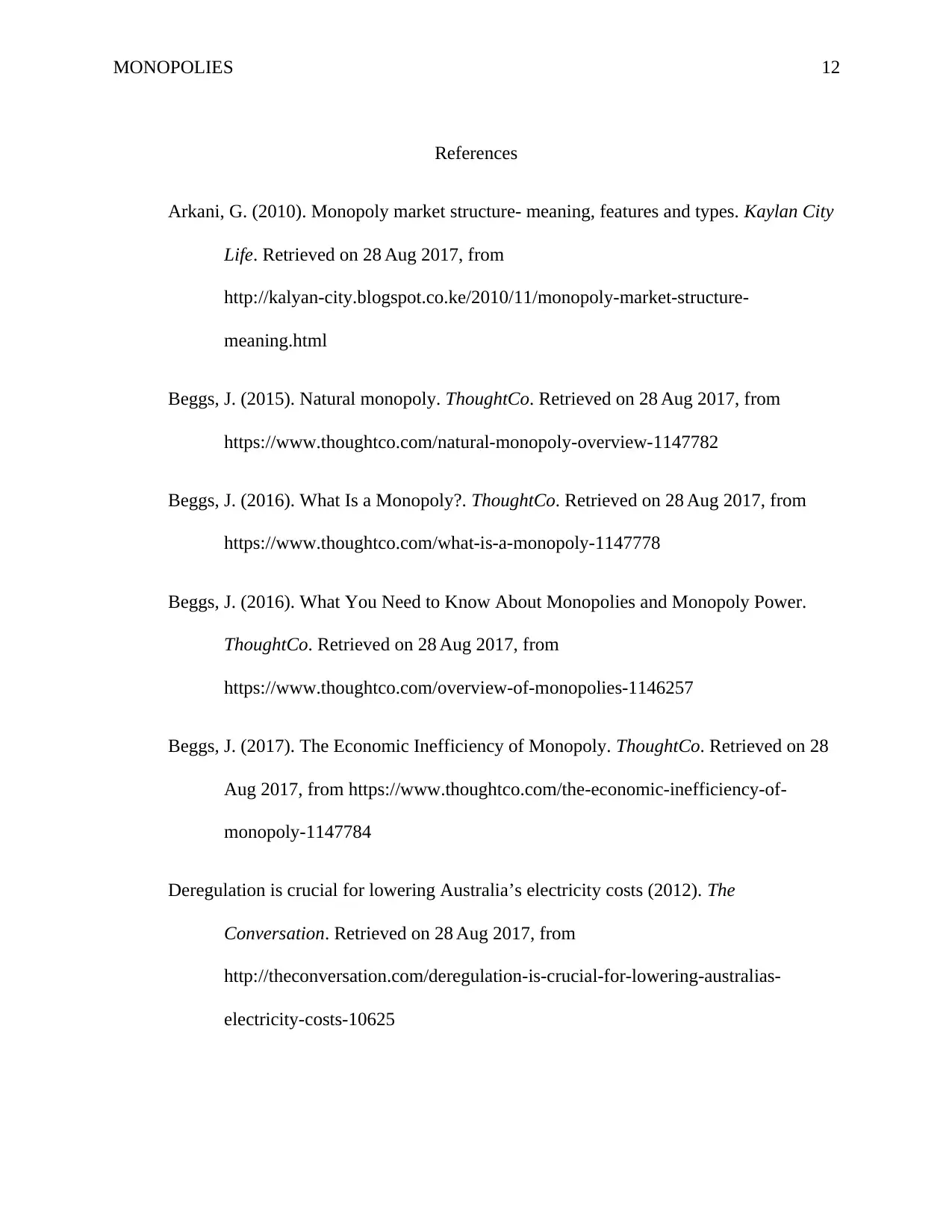
MONOPOLIES 12
References
Arkani, G. (2010). Monopoly market structure- meaning, features and types. Kaylan City
Life. Retrieved on 28 Aug 2017, from
http://kalyan-city.blogspot.co.ke/2010/11/monopoly-market-structure-
meaning.html
Beggs, J. (2015). Natural monopoly. ThoughtCo. Retrieved on 28 Aug 2017, from
https://www.thoughtco.com/natural-monopoly-overview-1147782
Beggs, J. (2016). What Is a Monopoly?. ThoughtCo. Retrieved on 28 Aug 2017, from
https://www.thoughtco.com/what-is-a-monopoly-1147778
Beggs, J. (2016). What You Need to Know About Monopolies and Monopoly Power.
ThoughtCo. Retrieved on 28 Aug 2017, from
https://www.thoughtco.com/overview-of-monopolies-1146257
Beggs, J. (2017). The Economic Inefficiency of Monopoly. ThoughtCo. Retrieved on 28
Aug 2017, from https://www.thoughtco.com/the-economic-inefficiency-of-
monopoly-1147784
Deregulation is crucial for lowering Australia’s electricity costs (2012). The
Conversation. Retrieved on 28 Aug 2017, from
http://theconversation.com/deregulation-is-crucial-for-lowering-australias-
electricity-costs-10625
References
Arkani, G. (2010). Monopoly market structure- meaning, features and types. Kaylan City
Life. Retrieved on 28 Aug 2017, from
http://kalyan-city.blogspot.co.ke/2010/11/monopoly-market-structure-
meaning.html
Beggs, J. (2015). Natural monopoly. ThoughtCo. Retrieved on 28 Aug 2017, from
https://www.thoughtco.com/natural-monopoly-overview-1147782
Beggs, J. (2016). What Is a Monopoly?. ThoughtCo. Retrieved on 28 Aug 2017, from
https://www.thoughtco.com/what-is-a-monopoly-1147778
Beggs, J. (2016). What You Need to Know About Monopolies and Monopoly Power.
ThoughtCo. Retrieved on 28 Aug 2017, from
https://www.thoughtco.com/overview-of-monopolies-1146257
Beggs, J. (2017). The Economic Inefficiency of Monopoly. ThoughtCo. Retrieved on 28
Aug 2017, from https://www.thoughtco.com/the-economic-inefficiency-of-
monopoly-1147784
Deregulation is crucial for lowering Australia’s electricity costs (2012). The
Conversation. Retrieved on 28 Aug 2017, from
http://theconversation.com/deregulation-is-crucial-for-lowering-australias-
electricity-costs-10625
⊘ This is a preview!⊘
Do you want full access?
Subscribe today to unlock all pages.

Trusted by 1+ million students worldwide
1 out of 13
Related Documents
Your All-in-One AI-Powered Toolkit for Academic Success.
+13062052269
info@desklib.com
Available 24*7 on WhatsApp / Email
![[object Object]](/_next/static/media/star-bottom.7253800d.svg)
Unlock your academic potential
Copyright © 2020–2025 A2Z Services. All Rights Reserved. Developed and managed by ZUCOL.





